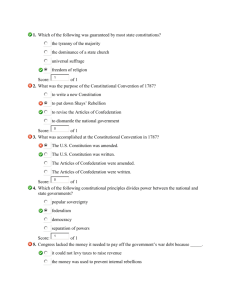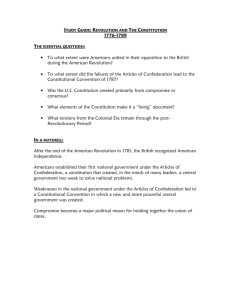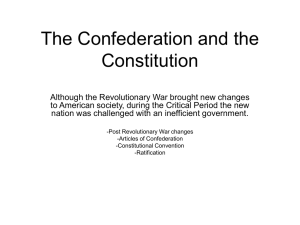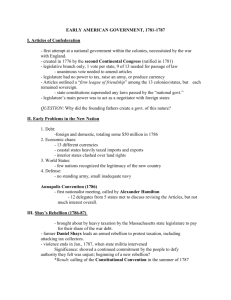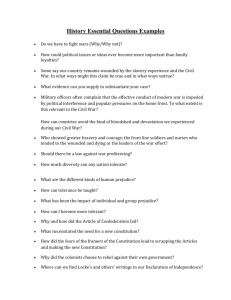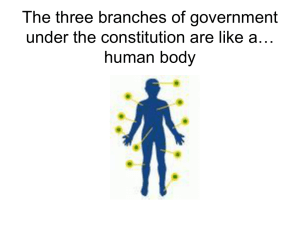The Constitutional Convention
advertisement
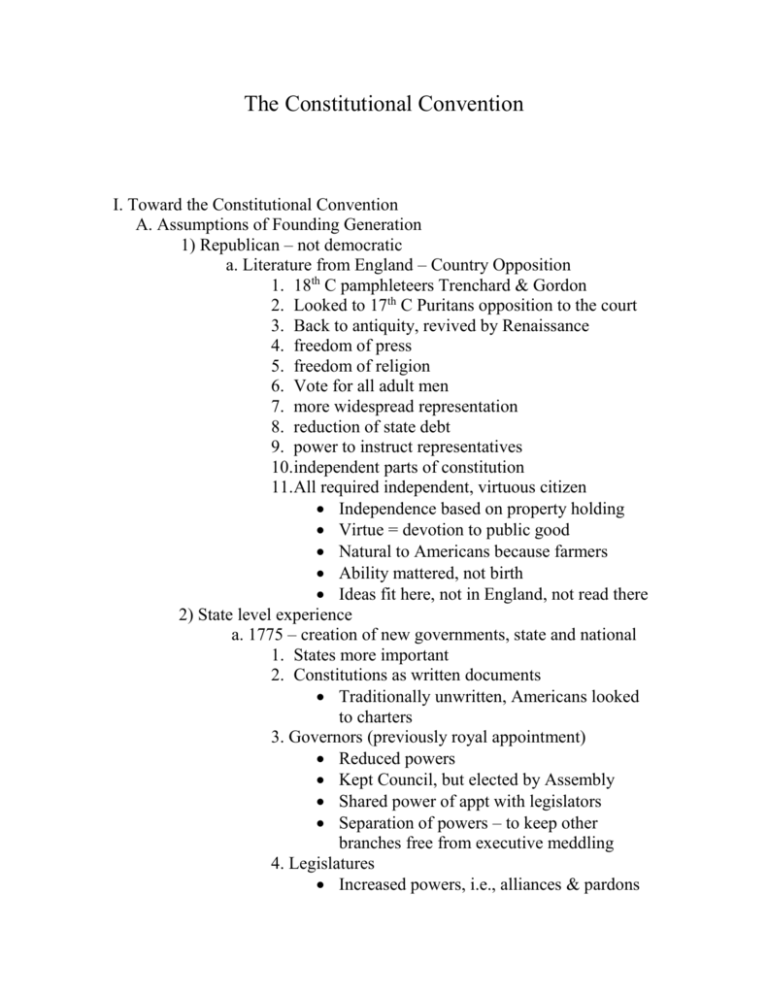
The Constitutional Convention I. Toward the Constitutional Convention A. Assumptions of Founding Generation 1) Republican – not democratic a. Literature from England – Country Opposition 1. 18th C pamphleteers Trenchard & Gordon 2. Looked to 17th C Puritans opposition to the court 3. Back to antiquity, revived by Renaissance 4. freedom of press 5. freedom of religion 6. Vote for all adult men 7. more widespread representation 8. reduction of state debt 9. power to instruct representatives 10.independent parts of constitution 11.All required independent, virtuous citizen Independence based on property holding Virtue = devotion to public good Natural to Americans because farmers Ability mattered, not birth Ideas fit here, not in England, not read there 2) State level experience a. 1775 – creation of new governments, state and national 1. States more important 2. Constitutions as written documents Traditionally unwritten, Americans looked to charters 3. Governors (previously royal appointment) Reduced powers Kept Council, but elected by Assembly Shared power of appt with legislators Separation of powers – to keep other branches free from executive meddling 4. Legislatures Increased powers, i.e., alliances & pardons Enlarged suffrage, with residence requirements Equal electoral districts, annual elections Power to instruct representatives Frontier- more representation b. 1780 – MA changed its constitution 1. Why? Problems at state level Combination of democratization of legislatures and change in power structure too much Example – NH – change in social character 1. 1765 – 34 members, all gentlemen 2. 1786 – 88 members, farmers or moderate wealth TOO representative of district, too selfinterested, not filled with republican virtue More laws passed 10 years after independence than during entire colonial period Growing fear of state legislatures rather than governors 1. violating rights of property for debtors: too much paper money debtor relief 1. taking over executive and judicial functions 2. 1780 – MA asked John Adams to write new constitution Legislature’s size & power reduced Senate created (not unique, but important) 1. long terms 2. high property qualifications Governors independent of legislature Judiciary also independent 1. began to restrain assembly A new constitution in 5 more years? 1. make constitution a “fundamental law” that legislature can’t alter 2. ratifying convention – people vote = higher source than legislature Model – PA, SC, GA, NH, DE, VT 3) National level experience a. Articles of Confederation – formal 1781 Continuation of 2nd Continental Congress Each state had one vote Power of diplomacy Power over Indian Affairs Power to coin & borrow money (states too) Requisitions Interstate disputes 1. Virginia Cession MD & RI wanted western lands pooled VA gave up chartered rights to the land Achievements 1. Revolution’s success 2. Ordinance of 1785 Surveyed land north of Ohio and West of Appalachians Townships – favored speculators & large groups 3. Northwest Ordinance Territorial governments Basic rights When population 60,000, can apply to become state Domestic Weaknesses 1. Apparent before A of C formal 2. Govt unstable and confused because congressmen served no more than 3 in 6 years 3. States ignored requisitions; CC stopped paying interest on public debt 4. Continental army resentful – no pay 5. Attempts to strengthen A of C failed because had to be unanimous Robert Morris, Supt of Finance, has asked for: 1. repeal of state paper money laws 2. requisitions paid in gold or silver 3. national bank 4. 5% impost to finance above – this would not pass 6. War’s end Congress disintegrated; hard to get a quorum States started to pay national debt International Weaknesses 1. Poor reputation led to: African capture of American ships Great Britain sent no minister, stayed in northwest posts France wouldn’t buy our goods British not allowing imports it didn’t allow before Revolution Confederation could not retaliate; states passed conflicting navigation acts Annapolis Convention – 1786 1. 12 delegates from 5 states 2. Called for Convention to amend AofC next year Shays’ Rebellion – 1786 1. Economy in shambles 2. Taxes increasing, debtors and many creditors in trouble 3. Unpopular Governor, Bowdoin 4. Capt. Daniel Shays, Rev War veteran, reluctantly became leader of debtor resistance 5. Started summer of 1786, most serious action in January of 1787, with fight at arsenal in Springfield 6. Confederation Congress told MA to raise army, but CC couldn’t pay for it, so MA officials paid for it themselves 7. It was suppressed, Shays left for NH, 5 convicted but ultimately pardoned 8. Shays’ Rebellion really worried Founding Fathers – economy bad everywhere, Confederation Congress incapable of dealing with the situation II. The Constitutional Convention A. Delegates 1) 55 from 12 states 2) Average age = 42 3) 39 had served in Continental Congress 4) 8 at state Constitutional Conventions 5) 7 state governors 6) 34 lawyers 7) 1/3 war veterans 8) Nearly all gentlemen 9) George Washington elected president 10) Voted to keep proceedings secret B. VA Plan – Edmund Randolph 1) Madison – real author - 37 – Father of Constitution – kept Journals 2) Bicameral Legislature (proportional rep in both) a. Power to legislate wherever states cannot b. Can veto state laws that oppose constitution 3) Single Executive 4) Separate Judiciary 5) Pt – no longer a confederation, but a federation C. NJ Plan – William Patterson 1) NJ, DE, NY, CT 2) Back to amend AofC a. Increase congressional power b. Maintain basic state sovereignty D. Kept basic provision of VA Plan 1) Bicameral Legislature a. Great or CT Compromise 1. Senate – each state gets 2 senators 2. Eased small states that feared large states b. Proportional rep in House of Representatives 1. Slaves counted as 3/5 – for South 2. No super majority for navigation laws - for N c. Enumerated Powers 1. tax 2. borrow & coin money 3. regulate commerce d. Art. 1, Sec. 10 prohibited states from: 1. diplomacy 2. tariffs 3. issuing coin & paper money 4. ex post facto laws 5. impairment of contracts (debtor relief) 6. states economically impotent 2) Single, strong Executive a. Choose own cabinet (with Senate) b. command over armed forces c. direct diplomacy d. 4 year term, perpetual re-eligibility e. elected by Electoral College, then House of Reps E. After months of debate, momentum favored new constitution 1) Battle still to be fought 2) 9 state approval, not unanimous 3) special ratifying conventions (MA model) – We the People 4) Not all delegates supported Constitution F. Unresolved issues: 1) Slavery 2) Suffrage for women G. Franklin’s answer to woman Virtue The Critical Period 1781-87


